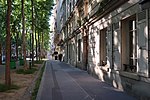Galerie des machines

The Galerie des machines (officially: Palais des machines) was a pavilion built for the 1889 Exposition Universelle in Paris. Located in the Grenelle district, the huge pavilion was made of iron, steel and glass. A similarly-named structure was erected for the 1878 Exposition Universelle, but the 1889 version was by far the largest vaulted building to have yet been built. It was reused for the 1900 Exposition Universelle as the Palace of Agriculture and Food (officially: Palais de l'Agriculture et des Aliments), and later used as a velodrome, agricultural exhibition hall and for other purposes and was demolished in 1910 to open up the view along the Champ de Mars.
Excerpt from the Wikipedia article Galerie des machines (License: CC BY-SA 3.0, Authors, Images).Galerie des machines
Place Joffre, Paris 7th Arrondissement (Paris)
Geographical coordinates (GPS) Address Website Nearby Places Show on map
Geographical coordinates (GPS)
| Latitude | Longitude |
|---|---|
| N 48.8536 ° | E 2.3018 ° |
Address
Grand palais éphémère (Arena Champs-de-Mars)
Place Joffre
75007 Paris, 7th Arrondissement (Paris)
Ile-de-France, France
Open on Google Maps










